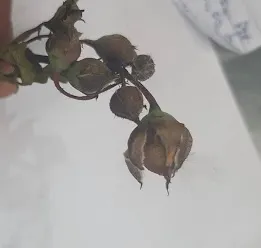
Managing Botrytis cinerea in Rose Plants
A way to use GraphQL-Codegen without having to commit the generated schema files to your repository or creating a security risk.

Overview
Roses are cherished for their beauty and economic value, but they are highly susceptible to diseases, particularly those caused by fungal pathogens. One such pathogen, Botrytis cinerea, is known for causing stem and root rot, leading to significant damage to rose plants. At Torus Biosciences, we conducted an in-depth study to identify effective biocontrol measures to combat this pervasive issue.
The Problem
Botrytis cinerea spreads via airborne spores and thrives in moist environments, making rose plants particularly vulnerable. The infection manifests as brown, irregular spots on leaves, early flower drop, and stem browning. If left unchecked, it can rapidly spread from the lower to upper plant regions, affecting young flower buds and causing widespread plant loss.
Our Research Approach
Sample Analysis
We collected samples from infected rose plants and observed them under laboratory conditions. The samples were cultured on a nutrient-rich mixture of Potato Dextrose Agar (PDA) and Nutrient Agar. After 10 days of incubation at 37°C, significant mycelial growth was observed, confirming the presence of Botrytis cinerea.
| Microscopic Image of Botrytis cinerea |
Testing Biocontrol Solutions
To mitigate the growth of Botrytis cinerea, we tested the following biocontrol agents:
- Pseudomonas fluorescens
- Bacillus subtilis
- Trichoderma viride
- Trichoderma harzianum
Using a dual culture technique, we assessed the ability of these agents to inhibit the growth of the pathogen.
| Day 1 vs. Day 10 vs. Day 15 |
Key Findings
- Effective Inhibition: Both Trichoderma viride and Trichoderma harzianum showed strong inhibitory effects on Botrytis cinerea, as did Pseudomonas fluorescens.
- Field Application: We developed a biocontrol treatment plan based on these findings, aimed at reducing fungal growth and promoting healthy plant development.
Results in lab trials
The biocontrol agents were tested in a controlled environment, and the results (approximately) were as follows:
show images
Suggested Treatment Plan
We recommended applying 1 liter per acre of a combination of Pseudomonas fluorescens and Trichoderma harzianum for effective control of Botrytis cinerea. This treatment should be repeated every 15 days to maintain optimal protection until the problem is resolved completely.
Conclusion
Our study demonstrates that strategic use of biocontrol agents can effectively manage Botrytis cinerea infections in rose plants. This natural approach supports sustainable cultivation practices, reduces chemical dependency, and improves plant health and yields.
For further information or to discuss collaboration opportunities, please reach out to Torus Biosciences.
Written by Arun kumar Gandlur on